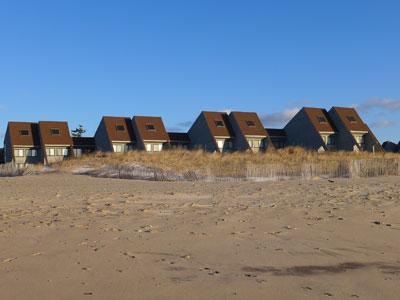D.E.C. Gives Corps the Go-Ahead
D.E.C. Gives Corps the Go-Ahead
A United States Army Corps of Engineers erosion-control project being planned for the downtown Montauk oceanfront has moved closer to reality with the issuing of a key state permit.
Meanwhile, activists have continued to try to stop it, launching an online petition drive and continuing to put pressure on East Hampton Town and Suffolk County officials and calling the project a dangerous precedent.
In a letter sent on Monday to the Army Corps, Roger Evans, the regional permit administrator for the New York Department of Environmental Conservation, signed off on a water quality permit for the project. The document was among several holdups that have put a planned March start to the work in doubt.
The plan is to place thousands of geotextile sandbags along a 3,100-foot-long section of the beach, then cover them with a three-foot-thick sand “veneer.”
Bids from private firms seeking to perform the work for the Army Corps have been delayed twice as specifications changed and questions remainedabout work-staging areas, drainage, and whether motel guests would be able to easily get to the beach once the artificial dune was complete.
A bid opening tentatively to take place yesterday was again delayed. Chris Gardner, a spokesman for the Army Corps, said on Tuesday that the project team was making progress finalizing the last details and that the bids might be opened at the end of the week.
Several of the 10 beachfront properties in the downtown Montauk area have been threatened in a series of storms, including Hurricane Sandy in 2012. Sand will be trucked in from an upland mine to build a roughly 60-foot-wide “enhanced beach berm seaward of the structure,” according to the D.E.C. permit.
East Hampton Town banned sandbags and other structural responses to erosion on the ocean in 2007. Officials have said that because the Army Corps work may be removed when its larger Fire Island to Montauk Point Reformulation Plan begins, the town ban and related state regulations do not apply.
The Army Corps plan includes several walkways at road ends and public paths for foot traffic to the beach, as well as crossing points for vehicles over the roughly 15-foot-high artificial dune.
The cost of maintaining what the state permit called an “installed system,” including patching and removing torn sandbags and replacing its sand covering in the event of a storm, is to be paid for jointly by the Town of East Hampton and Suffolk County, according to the permit.
Once billed as a single project, it is now being planned in two phases; the first had been set to begin later this month before the bid delays put that in doubt.
Kevin McAllister, an environmental activist and founder of Defend H20, and Rav Friedel, a longtime Montauk preservationist, attended a Tuesday session of the Suffolk Legislature.
Mr. McAllister said he told lawmakers that changes to the Army Corps specifications, including an increase in the quantity of sand to be trucked in, warranted a re-examination of the county’s financial commitment.
He said that he favored a sand-only alternative, without the planned 14,560 sandbags, as did Mr. Friedel.
Elected officials, Mr. McAllister said, were “onboard because it was a political hot-button issue.”
“If a bad project like this gets in, it may not be the last,” he said. “We are trying to hold it up, put the spotlight on it as poor policy. They are all acting in isolation, all reaction to hot spots and rubber-stamping these.”
Suffolk Legislator Al Krupski of Southold, who was the only member to vote against the county sharing in the Montauk project’s maintenance cost, said in an interview that he sensed a “lack of commitment” among his colleagues to revisit the arrangement, but that he would keep pressing for it.
“This is a tremendous liability to the county,” Mr. Krupski said. Allowing the sandbags to be installed closer to the ocean than originally planned will accelerate erosion and cause damage to nearby properties, he said. He was also concerned about the precedent. “Shoreline hardening should not be something that becomes normal,” he said.
“What I worry about is that 15 years go by and we’ve armored all our beaches, and we ask, ‘Where is our shoreline?’ This is an issue of regional significance,” Mr. McAllister said.
Sea-level rise made shoreline fortification like that planned for Montauk too great a risk for beach losses, he said. “Where is the science-based approach to all of this?”
A request for comment to Mr. Evans of the D.E.C. met with no reply.
For its part, the local chapter of the Surfrider environmental organization took the fight online last week. In a petition at Change.org, it said that the project jeopardized the public beach and will cost taxpayers “uncertain” ongoing maintenance expenses.
It said that the sandbag structure would “bump out” the shoreline and produce a “much higher rate of erosion than the naturally occurring rate.”
It also said that four well-known coastal geologists had visited the Montauk site and said that the Army Corps plan was “seriously flawed.”
In a September letter to officials, one of them, Robert Young, a geologist and director of Western Carolina University’s Program for the Study of Developed Shorelines in Cullowhee, N.C., wrote, “The geotextile wall will be exposed well before the projected lifespan is reached. The project will likely result in significant degradation of the public beach, while providing little protection for property.”








